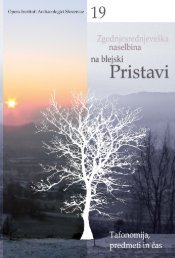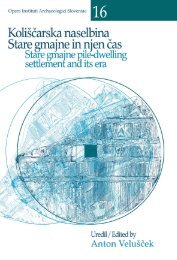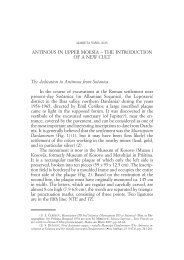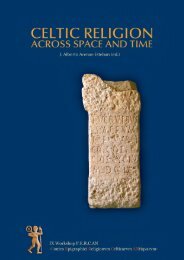The Roman conquest of Dalmatia and Pannonia under Augustus
The Roman conquest of Dalmatia and Pannonia under Augustus
The Roman conquest of Dalmatia and Pannonia under Augustus
Create successful ePaper yourself
Turn your PDF publications into a flip-book with our unique Google optimized e-Paper software.
Günther Moosbauer und Rainer Wiegels (Hrsg.)<br />
Fines imperii –<br />
imperium sine fi ne?
Osnabrücker Forschungen<br />
zu Altertum und Antike-Rezeption<br />
B<strong>and</strong> 14<br />
Herausgegeben von<br />
Günther Moosbauer und Rainer Wiegels
Günther Moosbauer und Rainer Wiegels (Hrsg.)<br />
Fines imperii –<br />
imperium sine fi ne?<br />
Römische Okkupations- und Grenzpolitik im frühen Principat<br />
Beiträge zum Kongress ‚Fines imperii – imperium sine fi ne?‘<br />
in Osnabrück vom 14. bis 18. September 2009<br />
Verlag Marie Leidorf GmbH . Rahden/Westf.<br />
2011
338 Seiten mit 99 Abbildungen<br />
Gedruckt mit fi nanzieller Unterstützung der<br />
STADT OSNABRÜCK<br />
GÖTTINGER AKADEMIE DER WISSENSCHAFTEN<br />
VARUS-GESELLSCHAFT ZUR FÖRDERUNG DER VOR- UND FRÜHGESCHICHTLICHEN<br />
AUSGRABUNGEN IM OSNABRÜCKER LAND E.V., OSNABRÜCK<br />
Bibliografi sche Information der Deutschen Nationalbibliothek<br />
Moosbauer, Günther ; Wiegels, Rainer (Hrsg.):<br />
Fines imperii – imperium sine fi ne? Römische Okkupations- und Grenzpolitik<br />
im frühen Principat / hrsg. von Günther Moosbauer ... .<br />
Rahden/Westf. : Leidorf, 2011<br />
(Osnabrücker Forschungen zu Altertum und Antike-Rezeption ; Bd. 14)<br />
ISBN 978-3-89646-735-5<br />
Die Deutsche Bibliothek verzeichnet diese Publikation in der Deutschen Nationalbibliografi e.<br />
Detaillierte bibliografi sche Daten sind im Internet über http://dnb.ddb.de abrufbar.<br />
Gedruckt auf alterungsbeständigem Papier<br />
Alle Rechte vorbehalten<br />
© 2011<br />
Verlag Marie Leidorf GmbH<br />
Geschäftsführer: Dr. Bert Wiegel<br />
Stellerloh 65 . D-32369 Rahden/Westf.<br />
Tel: +49/(0)5771/ 9510-74<br />
Fax: +49/(0)5771/ 9510-75<br />
E-Mail: info@vml.de<br />
Internet: www.vml.de<br />
ISBN 978-3-89646-735-5<br />
ISSN 1863-074X<br />
Kein Teil dieses Buches darf in irgendeiner Form (Druck, Fotokopie, CD-ROM, DVD, I n t e r n e t oder einem<br />
<strong>and</strong>eren Verfahren) ohne schriftliche Genehmigung des Verlages Marie Leidorf GmbH reproduziert werden<br />
oder unter Verwendung elektronischer Systeme verarbeitet, vervielfältigt oder verbreitet werden.<br />
Umschlagentwurf: COMPUTUS Druck Service, 55595 Gutenberg<br />
Titelfoto: Buchisstele 13 vom 17. April 29 v. Chr. - Minas Nerpel, Abb. 1 (in diesem B<strong>and</strong>)<br />
aus: R. Mond/O.H. Myers, <strong>The</strong> Bucheum III, London (EES) 1934 Taf. 43<br />
Redaktion: Achim Rost und Susanne Wilbers-Rost, Belm<br />
Satz und Layout: Enns Schrift & Bild GmbH, Bielefeld<br />
Internet: http://www.geschichte.uni-osnabrueck.de/80.htm<br />
Druck und Produktion: Druckhaus Breyer GmbH, Diepholz
Inhaltsverzeichnis<br />
Vorwort ....................................................................... 7<br />
<strong>The</strong> <strong>Roman</strong> occupation in the north <strong>of</strong> Hispania: war, military deployment<br />
<strong>and</strong> cultural integration<br />
Ángel Morillo .................................................................. 11<br />
Römer und gentes Alpinae im Konfl ikt – archäologische und historische Zeugnisse<br />
des 1. Jahrh<strong>under</strong>ts v. Chr.<br />
Stefanie Martin-Kilcher .......................................................... 27<br />
L’armée romaine et les peuples gaulois de César à Auguste<br />
Michel Reddé ................................................................... 63<br />
Römische und indigene Strategien der Herrschafts- und Friedenssicherung<br />
– Germanien –<br />
Siegmar von Schnurbein .......................................................... 75<br />
‘Perdomita Britannia…’: <strong>Roman</strong> <strong>and</strong> indigenous strategies <strong>and</strong> their outcomes<br />
in Britain from Caesar to Domitian <strong>and</strong> beyond<br />
Simon James ................................................................... 87<br />
<strong>The</strong> <strong>Roman</strong> <strong>conquest</strong> <strong>of</strong> <strong>Dalmatia</strong> <strong>and</strong> <strong>Pannonia</strong> <strong>under</strong> <strong>Augustus</strong> –<br />
some <strong>of</strong> the latest research results<br />
Marjeta Šašel Kos ............................................................... 107<br />
Domitian und die Donaugrenze<br />
Miroslava Mirković .............................................................. 119<br />
<strong>Augustus</strong>, Prinzeps und Pharao zwischen politischer Realität<br />
und ideologischem Anspruch<br />
Martina Minas-Nerpel ............................................................ 131<br />
Rome <strong>and</strong> Judaea during the First Century CE: A strange modus vivendi<br />
Moshe Fischer .................................................................. 143<br />
<strong>The</strong> Transformation <strong>of</strong> Rural Structures in Southern Gaul between the 1st Century BC<br />
<strong>and</strong> the 1st Century AD. <strong>The</strong> Case <strong>of</strong> Eastern Languedoc.<br />
François Favory, Marie-Jeanne Ouriachi <strong>and</strong> Laure Nuninger ............................. 157<br />
Die Transformation der L<strong>and</strong>wirtschaft in Germanien und Raetien<br />
Günther Moosbauer .............................................................. 185<br />
Integration der lokalen Eliten – individuelle und korporative Privilegierungen<br />
Helmut Halfmann ............................................................... 195<br />
Household specialisation in horse breeding:<br />
the role <strong>of</strong> returning veterans in the Batavian river area<br />
Maaike Groot ................................................................... 203<br />
Les dieux, la cité et le pouvoir impérial. Religions et intégration<br />
des provinces de l’Occident romain<br />
William Van Andringa ........................................................... 219
6<br />
Tradition – Persistenz – Resistenz: Kultmonumente, Kulte und Akkulturation<br />
in Nordafrika, Kleinasien und Lusitanien<br />
Günther Schörner ................................................................ 227<br />
La violence et la guerre chez les Romains au temps d’Auguste<br />
Yann Le Bohec .................................................................. 239<br />
Zwischen Integration und Segregation – eine Problemskizze zum Verhältnis<br />
zwischen römischem Heer und Zivilgesellschaft im Principat.<br />
Rainer Wiegels .................................................................. 253<br />
Monumentalisierung römischer Macht – augusteische Stadtanlagen<br />
zwischen „Monotonisierung“ und imitatio Urbis<br />
Sabine Panzram ................................................................. 275<br />
Der Kaiserkult als Mittel der politischen Integration<br />
Peter Herz ...................................................................... 297<br />
<strong>The</strong> friendly kings. Politics, culture <strong>and</strong> religion in the East.<br />
Ariel S. Lewin .................................................................. 309<br />
Peace as <strong>The</strong> Highest End <strong>and</strong> Good? <strong>The</strong> Role <strong>of</strong> Peace<br />
in <strong>Roman</strong> Thought <strong>and</strong> Politics<br />
Kurt A. Raafl aub ................................................................ 323
<strong>The</strong> northeastern hinterl<strong>and</strong> <strong>of</strong> Cisalpine Gaul was<br />
gradually conquered after the founding <strong>of</strong> Aquileia<br />
in 181 BC. 1 Under the proconsulship <strong>of</strong> Caesar in<br />
both Galliae <strong>and</strong> Illyricum, Cisalpine Gaul was<br />
extended across the Ocra Pass (Fig. 1) towards the<br />
Emona Basin, where Aquileia founded its easternmost<br />
settlement (vicus) <strong>and</strong> an important emporium<br />
at Nauportus. 2 After the pact <strong>of</strong> Brundisium in 40<br />
BC, Octavian acquired almost the entire Illyricum,<br />
while the southeastern part was assigned to Antony;<br />
in the course <strong>of</strong> his Illyrian War (35-33 BC), 3 Octavian<br />
conquered (in addition to many less important<br />
peoples) the Iapodes, parts <strong>of</strong> <strong>Pannonia</strong> around Segestica/Siscia,<br />
as well as the Delmatae <strong>and</strong>, it seems,<br />
the part <strong>of</strong> Illyricum belonging to Antony. 4 Most <strong>of</strong><br />
the future <strong>Pannonia</strong> <strong>and</strong> <strong>Dalmatia</strong>, however, was<br />
conquered by Tiberius in his <strong>Pannonia</strong>n War <strong>and</strong> in<br />
the <strong>Pannonia</strong>n-<strong>Dalmatia</strong>n Rebellion. 5<br />
Noricum<br />
Noricum was more or less peacefully annexed<br />
shortly before the outbreak <strong>of</strong> the <strong>Pannonia</strong>n War.<br />
<strong>The</strong> Ambisontes were the only hostile Norican people,<br />
<strong>and</strong> Dio actually mentioned an incursion by the<br />
<strong>Pannonia</strong>ns together with the Norici into Histria in<br />
16 BC. 6 Regardless <strong>of</strong> who the Norican rebels had<br />
been (they cannot be identifi ed with certainty), 7<br />
their insurrection was the reason for the annexation<br />
<strong>of</strong> the Norican kingdom. Indeed, the independent<br />
minting <strong>of</strong> Norican tetradrachmas ended around<br />
16-15 BC. 8 A vexillation <strong>of</strong> the legion VIII Augusta,<br />
together with a detachment <strong>of</strong> the cohors Montano-<br />
1<br />
BANDELLI 2003; VEDALDI IASBEZ 2003; BANDELLI 2009; ZAC-<br />
CARIA 2009.<br />
2<br />
For Caesar‘s proconsulship: ŠAŠEL KOS 2000; for the Ocra<br />
Pass: Strabo 7. 5. 2 C 314; HORVAT / BAVDEK 2009; for Nauportus:<br />
HORVAT 1990; MUŠIČ / HORVAT 2007.<br />
3<br />
ŠAŠEL KOS 2005, 393 ff.<br />
4<br />
MIRKOVIĆ 1968; ŠAŠEL KOS 1999.<br />
5 ŠAŠEL KOS 2009a.<br />
<strong>The</strong> <strong>Roman</strong> <strong>conquest</strong> <strong>of</strong> <strong>Dalmatia</strong> <strong>and</strong> <strong>Pannonia</strong><br />
<strong>under</strong> <strong>Augustus</strong> – some <strong>of</strong> the latest research results<br />
6 Cassius Dio 54. 20. 2.<br />
7 Perhaps the Norican Taurisci, mentioned by Strabo (4. 6. 12<br />
C 208), or the Ambisontes (?) in the Aesontius (Soča/Isonzo)<br />
valley, ŠAŠEL 1972 (1992). On the Ambisontes (?) in the territory<br />
<strong>of</strong> Iuvavum, see HÖGLINGER 2004.<br />
8 GÖBL 1973, 63; Kos 1977, 20.<br />
Marjeta Šašel Kos<br />
rum prima (both belonging to the <strong>Pannonia</strong>n part <strong>of</strong><br />
the army <strong>of</strong> Illyricum), was stationed in the <strong>Roman</strong><br />
emporium at Virunum/Magdalensberg. 9 In the light<br />
<strong>of</strong> the recent discussion <strong>of</strong> a passage from the <strong>Roman</strong><br />
History <strong>of</strong> Velleius Paterculus (who had been<br />
Tiberius’ <strong>of</strong>fi cer), where he says that Tiberius subdued<br />
“Raetia <strong>and</strong> the Vindelici, the Norici <strong>and</strong> <strong>Pannonia</strong>,<br />
as well as the Scordisci,” <strong>and</strong> added them as<br />
“new provinces” to the <strong>Roman</strong> state, 10 it can be<br />
argued that after the Alpine campaigns in 15 BC <strong>and</strong><br />
the subsequent <strong>Pannonia</strong>n War, all these countries<br />
came in one way or another <strong>under</strong> <strong>Roman</strong> dominion.<br />
However, contrary to the recent opinion that these<br />
regions became provinces early in the reign <strong>of</strong><br />
Tiberius, 11 Velleius’ claim perhaps implies Augustan<br />
involvement after Tiberius’ military victories. 12<br />
<strong>The</strong>se provinces were at fi rst <strong>under</strong> military supervision,<br />
<strong>and</strong> only subsequently were provincial governors<br />
installed in them, in Noricum probably as<br />
late as Claudius; C. Baebius Atticus may still be<br />
regarded as the fi rst presidial procurator. 13<br />
<strong>The</strong> <strong>Pannonia</strong>n War<br />
<strong>The</strong> <strong>Pannonia</strong>n War, conducted by Tiberius, lasted<br />
for two years, from 12 to 11 BC, 14 although the<br />
quelling <strong>of</strong> several uprisings in the <strong>Pannonia</strong>n <strong>and</strong><br />
<strong>Dalmatia</strong>n parts <strong>of</strong> Illyricum is documented<br />
between 14 <strong>and</strong> 8 BC. 15 By that time, most <strong>of</strong> Illyricum<br />
had been conquered. Cassius Dio is the best<br />
authority for this poorly attested war, even if his<br />
summary account is short <strong>and</strong> devoid <strong>of</strong> all detail. 16<br />
He mentioned that the <strong>Pannonia</strong>ns “again revolted”<br />
in 14 BC, probably referring to their incursion into<br />
Histria together with the Noricans two years previously.<br />
It seems that the proconsul <strong>of</strong> Illyricum at<br />
9<br />
ŠAŠEL 1986 (1992); PICCOTTINI 2003.<br />
10<br />
Velleius 2. 39. 3.<br />
11<br />
BRAUNERT 1977; ROLLINGER 2001; SCHAUB 2001; GAMPER 2007.<br />
12<br />
GRAßL 2008.<br />
13<br />
See, recently, WEBER 2008; for a different opinion, however,<br />
see ZACCARIA 2001, 146-148. MAINARDIS 2008, 135-141, particularly<br />
138-139.<br />
14<br />
DOMIĆ KUNIĆ 2006.<br />
15<br />
ŠAŠEL KOS 1986, 154 ff.<br />
16<br />
Cassius Dio 54. 28. 1-2; 31. 2-4; 34. 3-4; 36. 2; 55. 2. 4.
108 Šašel Kos, <strong>The</strong> <strong>Roman</strong> <strong>conquest</strong> <strong>of</strong> <strong>Dalmatia</strong> <strong>and</strong> <strong>Pannonia</strong> <strong>under</strong> <strong>Augustus</strong><br />
Fig. 1 <strong>The</strong> Ocra Pass below Mt. Ocra (present-day Nanos). From HORVAT / BAVDEK 2009, 21.<br />
that time was M. Vinicius, since it is reported that<br />
he fought against them. 17 Probably the military situation<br />
in <strong>Pannonia</strong>, on the fringes <strong>of</strong> Italy, became so<br />
precarious that it dem<strong>and</strong>ed the presence <strong>of</strong> an<br />
experienced army leader. One year later, comm<strong>and</strong><br />
was given to the best <strong>Roman</strong> general, M. Vipsanius<br />
Agrippa, who inspired such terror among the <strong>Pannonia</strong>ns<br />
that they acknowledged <strong>Roman</strong> authority<br />
without further fi ghting. <strong>The</strong>y rebelled again after<br />
Agrippa’s death in 12 BC, <strong>and</strong> the war continued<br />
<strong>under</strong> Tiberius; Dio, referring to 12 BC, wrote that<br />
Tiberius had put down the rebellion <strong>and</strong> then conquered<br />
most <strong>of</strong> the country with the help <strong>of</strong> the<br />
allied Scordisci, an important Celtic people living<br />
in the broad region around the confl uence <strong>of</strong> the<br />
Sava <strong>and</strong> the Danube (Fig. 2). Tiberius took away<br />
all the arms <strong>of</strong> the <strong>Pannonia</strong>ns <strong>and</strong> sold most <strong>of</strong><br />
their youth abroad. For his victories he was awarded<br />
triumphal honours, although the Senate had voted<br />
him a triumph. 18<br />
Dio mentioned for 11 BC that Tiberius conquered<br />
the Delmatae, who had meanwhile rebelled against<br />
<strong>Roman</strong> authority. He had to wage war against both<br />
peoples, the Delmatae <strong>and</strong> the <strong>Pannonia</strong>ns, march-<br />
17<br />
Velleius 2. 96. 2; Florus 2. 24; FITZ 1993, 44-46.<br />
18<br />
Cassius Dio 54. 31. 2-4.<br />
ing from one battlefi eld to another. After the defeat<br />
<strong>of</strong> the Delmatae, <strong>Dalmatia</strong> came <strong>under</strong> the supervision<br />
<strong>of</strong> <strong>Augustus</strong>, since it needed a military garrison<br />
both on account <strong>of</strong> the unstable situation in the<br />
country <strong>and</strong> because <strong>of</strong> the vicinity to the dangerous<br />
<strong>Pannonia</strong>ns. 19 For the year 10 BC, Dio reported<br />
that the Dacians crossed the frozen Danube <strong>and</strong><br />
pl<strong>under</strong>ed <strong>Pannonia</strong>, while the Delmatae refused to<br />
pay tributes. Tiberius had to return from Gaul to<br />
cope with the situation. 20 Revolts in both parts <strong>of</strong><br />
Illyricum continued in the next year, <strong>and</strong> even in 8<br />
BC the <strong>Pannonia</strong>ns had to be subdued by Sex.<br />
Appuleius. 21<br />
Most <strong>of</strong> <strong>Pannonia</strong> must have been conquered during<br />
the <strong>Pannonia</strong>n War, although no <strong>Pannonia</strong>n peoples<br />
are specifi cally mentioned by name. <strong>The</strong> immediate<br />
neighbours <strong>of</strong> Tiberius’ allies, the Scordisci, were<br />
the Breuci <strong>and</strong> Amantini, thus they were no doubt<br />
among the conquered peoples; the latter were settled<br />
in the region <strong>of</strong> Sirmium <strong>and</strong> Bassianae. Interesting<br />
light is shed on this problem by a cenotaph for a tenyear-old<br />
boy <strong>of</strong> the Amantini (found in the village <strong>of</strong><br />
Putinci in eastern Syrmia), who was drowned in the<br />
19<br />
Cassius Dio 54. 34. 3-4.<br />
20<br />
Cassius Dio 54. 36. 2.<br />
21<br />
Cassiodorus, MGH, Chron. min. I 135. See FITZ 1993, 57.
Osnabrücker Forschungen zu Altertum und Antike-Rezeption 14 109<br />
river at Emona, where he had been taken hostage. 22<br />
<strong>The</strong> inscription is a unique epigraphic testimony to<br />
confi rm the <strong>Roman</strong> practice <strong>of</strong> taking hostages,<br />
very well attested by Appian <strong>and</strong> other historians.<br />
Emona was the last Italian city on the way to <strong>Pannonia</strong>;<br />
that it belonged to Italy is now clear from the<br />
recently discovered boundary inscription. 23 <strong>The</strong> boy<br />
was called [S]cemaes <strong>of</strong> the gens Undia (perhaps<br />
Scenas or Sceuas; the names may be corrupt), no<br />
doubt belonging to an upper class family. He was<br />
from the second centuria, either referring to the<br />
number <strong>of</strong> hostages or, perhaps, to a tribal division<br />
<strong>of</strong> some kind among the Amantini. 24<br />
Illyricum, then the name <strong>of</strong> the undivided province,<br />
extended as far as the Danube. This was empha-<br />
22 CIL III 3224; ŠAŠEL KOS 2009, 93.<br />
23 ŠAŠEL KOS 2002.<br />
24 DUŠANIĆ 1967, 67.<br />
Fig. 2 <strong>The</strong> peoples <strong>of</strong> Upper <strong>and</strong> Lower Illyricum. From ŠAŠEL, in Keltoi, 1983, 13.<br />
sised by <strong>Augustus</strong> in the inscription commemorating<br />
his deeds (Res gestae): “I subjected to <strong>Roman</strong><br />
rule, through Tiberius Nero who was then my stepson<br />
<strong>and</strong> legate, certain <strong>Pannonia</strong>n tribes that had<br />
not been reached by a <strong>Roman</strong> army before my reign,<br />
thereby extending the frontier <strong>of</strong> Illyricum as far as<br />
the Danube.” 25 However, not all <strong>of</strong> the later <strong>Pannonia</strong><br />
was subdued during the <strong>Pannonia</strong>n War, <strong>and</strong> it<br />
is not quite clear how these famous words – “protulique<br />
fi nes Illyrici ad ripam fl uminis Danuvii” –<br />
should be correctly <strong>under</strong>stood. How <strong>and</strong> when did<br />
the <strong>Roman</strong>s reach the Danube, <strong>and</strong> which part <strong>of</strong><br />
the river was it? Appian had already mentioned that<br />
Octavian had ships constructed on the Savus River<br />
during his Illyrian War. He intended to use them in<br />
his planned campaign against the Dacians to transport<br />
provisions for his army to the Danube. 26 In the<br />
25<br />
Mon. Ancyr. 30; TÓTH 1977.<br />
26<br />
Appian Illyr. 22. 65-66; ŠAŠEL KOS 2005, 440.
110 Šašel Kos, <strong>The</strong> <strong>Roman</strong> <strong>conquest</strong> <strong>of</strong> <strong>Dalmatia</strong> <strong>and</strong> <strong>Pannonia</strong> <strong>under</strong> <strong>Augustus</strong><br />
course <strong>of</strong> Octavian’s actions, which were to a large<br />
extent also diplomatic, it would not be impossible<br />
that a detachment <strong>of</strong> Octavian’s army might have<br />
reached the Danube, as he is said to have expressly<br />
claimed before the battle at Actium. 27 In this context,<br />
we should most probably <strong>under</strong>st<strong>and</strong> “the Danube”<br />
to mean the river’s course near Sirmium.<br />
In his Res gestae, <strong>Augustus</strong> was most probably<br />
referring to the <strong>Pannonia</strong>n peoples, <strong>of</strong> which the<br />
Andizetes are known to have been the northernmost,<br />
<strong>and</strong> not to the Celtic population <strong>of</strong> the later<br />
<strong>Pannonia</strong>, living north <strong>of</strong> the Dravus River. 28 Some<br />
<strong>of</strong> these Celtic peoples may have been more or less<br />
dependent on the Norican kingdom <strong>and</strong> consequently<br />
not hostile to the <strong>Roman</strong>s; most <strong>of</strong> their<br />
regions may have been peacefully annexed. <strong>The</strong><br />
<strong>Roman</strong> frontier in <strong>Pannonia</strong> shifted along with new<br />
<strong>conquest</strong>s, <strong>and</strong> it may well be that the entire course<br />
<strong>of</strong> the Danube was not fi rmly in <strong>Roman</strong> h<strong>and</strong>s<br />
before Claudius. Stages in the limes development<br />
no doubt existed: fi rst <strong>of</strong> all, a strong military line<br />
along the upper Sava River would certainly have<br />
been very important in order to capture Segesta/<br />
Siscia <strong>and</strong> annex its territory. <strong>The</strong> lower course <strong>of</strong><br />
the river, as well as the Drava <strong>and</strong> most <strong>of</strong> the Danube,<br />
had not been conquered before the <strong>conquest</strong>s<br />
<strong>of</strong> Tiberius. <strong>The</strong> legionary camp at Siscia, dating<br />
back to Octavian, 29 was much earlier than those at<br />
Poetovio <strong>and</strong> Sirmium. 30<br />
<strong>The</strong> <strong>Pannonia</strong>n-<strong>Dalmatia</strong>n Rebellion<br />
However, war preparations against Maroboduus, particularly<br />
the recruitment <strong>of</strong> soldiers, triggered the outbreak<br />
<strong>of</strong> the rebellion in Illyricum (Fig. 3), towards<br />
the end <strong>of</strong> which the large area with fi ve legions was<br />
divided into an upper (<strong>Dalmatia</strong>) <strong>and</strong> a lower (<strong>Pannonia</strong>)<br />
province. 31 According to Velleius Paterculus,<br />
who himself took part in the war, bringing new<br />
recruits from Rome to Tiberius, the collective number<br />
<strong>of</strong> rebels would have amounted to 800,000, including<br />
200,000 infantrymen <strong>and</strong> 9000 cavalry. 32 Expe-<br />
27<br />
Cassius Dio 50. 24. 4; ŠAŠEL KOS, ib.<br />
28<br />
FITZ 1998; id. 1993, 13–14.<br />
29<br />
RADMAN-LIVAJA 2007, 161 ff.<br />
30<br />
Poetovio: some time after 15 BC, see HORVAT et al. 2003,<br />
156; Sirmium: a <strong>Roman</strong> stronghold attested in AD 6: MIRKOVIĆ<br />
2004, 147.<br />
31<br />
KOVÁÁCS 2008, with earlier literature; ŠAŠEL KOS 2010.<br />
32<br />
Velleius 2. 110. 3. Appian, however, noted that there had<br />
been a total <strong>of</strong> 100,000 men capable <strong>of</strong> fi ghting among the <strong>Pannonia</strong>ns<br />
at the time <strong>of</strong> Octavian’s Illyrian war (Appian Illyr. 22.<br />
63). This is closer to reality, cf. also DŽINO 2006.<br />
rienced comm<strong>and</strong>ers <strong>of</strong> this army planned – with<br />
part <strong>of</strong> it – to attack Italy, which was connected to<br />
their territory by the border areas <strong>of</strong> Nauportus <strong>and</strong><br />
Tergeste; part <strong>of</strong> the army would invade Macedonia,<br />
while the third part was intended to defend<br />
their own territories. 33 <strong>The</strong>ir leaders, both Batos<br />
<strong>and</strong> Pinnes, enjoyed great authority; the army was<br />
disciplined – some even knew Latin <strong>and</strong> were<br />
acquainted with <strong>Roman</strong> culture. 34 <strong>The</strong>y attacked<br />
<strong>Roman</strong> citizens, killing merchants <strong>and</strong> many veterans,<br />
who were settled at some distance from the<br />
<strong>Roman</strong> garrisons. <strong>The</strong>y occupied (parts <strong>of</strong>) Macedonia,<br />
causing great damage everywhere. 35<br />
Velleius fi rst mentioned the victory <strong>of</strong> M. Valerius<br />
Messalla Messallinus, praepositus <strong>of</strong> Illyricum,<br />
who had been trapped by the enemy with half <strong>of</strong> the<br />
20 th legion. Next he narrated the battles near Mons<br />
Claudius (Požeška brda [Požeška Hills], northeast<br />
<strong>of</strong> Siscia), occupied by the rebels, who almost<br />
defeated the army brought from the transmarine<br />
provinces by A. Caecina Severus <strong>and</strong> M. Plautius<br />
Silvanus. This army consisted <strong>of</strong> fi ve legions with<br />
auxiliary soldiers, accompanied by a detachment <strong>of</strong><br />
horsemen <strong>under</strong> the Thracian king Rhoemetalces.<br />
For a short time, the entire army was stationed in<br />
one camp at Siscia, composed <strong>of</strong> ten legions, more<br />
than seventy cohorts, ten alae, <strong>and</strong> over ten thous<strong>and</strong><br />
veterans. Since it was impossible to control<br />
such a huge force, however, Tiberius accompanied<br />
the new legions back to their provinces, returning<br />
to Siscia at the beginning <strong>of</strong> the winter. <strong>The</strong> next<br />
summer, <strong>Pannonia</strong> capitulated <strong>and</strong> the rebels deposited<br />
their arms at the Bathinus River (the Bosna).<br />
Comm<strong>and</strong> over the army in the winter camp at Siscia<br />
was given to M. Aemilius Lepidus. 36<br />
At the beginning <strong>of</strong> the summer <strong>of</strong> AD 9, Lepidus<br />
set <strong>of</strong>f to join Tiberius in <strong>Dalmatia</strong>, traversing<br />
regions as yet untouched by the war, where he had<br />
to fi ght the enemy on all sides. Germanicus <strong>and</strong> C.<br />
Vibius Postumus, praepositus <strong>of</strong> <strong>Dalmatia</strong>, also<br />
successfully fought in the <strong>Dalmatia</strong>n part <strong>of</strong> Illyricum.<br />
That summer saw the end <strong>of</strong> the war, with the<br />
Perustae, Desidiates <strong>and</strong> the Delmatae decisively<br />
33<br />
DZINo 2010, 147 refuses to give credit to this plan, which,<br />
however, is partly confi rmed by subsequent <strong>Roman</strong> strategy<br />
<strong>and</strong> actions, <strong>and</strong> indirectly also by the account <strong>of</strong> Cassius Dio<br />
(see infra).<br />
34<br />
Velleius 2. 110. 5: Velleius‘ optimistic remark could have<br />
referred to a few only, cf. ALFÖLDY 1995, 26.<br />
35<br />
Velleius 2. 110.<br />
36<br />
Velleius 2. 111-114; commentary in RADMAN-LIVAJA / DIZ-<br />
DAR 2010; some aspects in Džino 2009.
Osnabrücker Forschungen zu Altertum und Antike-Rezeption 14 111<br />
Fig. 3 <strong>The</strong> outbreak <strong>of</strong> the <strong>Pannonia</strong>n-<strong>Dalmatia</strong>n rebellion in AD 6. Following ŠAŠEL KOS 1986, 191<br />
(computer graphics M. Belak).<br />
defeated. 37 Velleius intended to describe the “<strong>Pannonia</strong>n<br />
<strong>and</strong> <strong>Dalmatia</strong>n war” – as he calls it – in a<br />
special volume. Shortly after the war in Illyricum<br />
ended, news came <strong>of</strong> the defeat <strong>of</strong> P. Quinctilius<br />
Varus in Germany.<br />
<strong>The</strong> account <strong>of</strong> Cassius Dio, although fragmentary<br />
in parts, is nonetheless more comprehensive; it is<br />
partially different, but also partially complementary.<br />
However, it is only possible to combine their differing<br />
data in a hypothetical manner. 38 Dio mentioned<br />
the attack <strong>of</strong> the Breuci <strong>under</strong> Bato on<br />
Sirmium, which must have become an important<br />
<strong>Roman</strong> stronghold after the <strong>Pannonia</strong>n War; it was<br />
37 Velleius 2. 115-117.<br />
38 <strong>The</strong> course <strong>of</strong> the rebellion is usually presented as a combined<br />
narrative in modern commentaries, from the earliest (cited<br />
in ŠAŠEL KOS 1986, 180-182) to the latest in DZINO 2010, 142<br />
ff. Some <strong>of</strong> the hypotheses, however, already fi gure as facts,<br />
which is misleading.<br />
saved by Caecina Severus, comm<strong>and</strong>er <strong>of</strong> the army<br />
from Moesia. Meanwhile, the Delmataean Bato,<br />
who had been injured during the siege <strong>of</strong> Salonae,<br />
where he had achieved nothing, pl<strong>under</strong>ed the coast<br />
as far as Apollonia, where he defeated the <strong>Roman</strong>s.<br />
In a joint action with the Breucian Bato, they took<br />
Mt. Alma (Fruška gora, to the far north <strong>of</strong> Sirmium),<br />
but were defeated by Thracian Rhoemetalces, who<br />
had been sent ahead by Caecina Severus. Severus,<br />
however, was unable to conquer them, <strong>and</strong>, moreover,<br />
had to return to Moesia, which had been invaded<br />
in his absence by the Dacians <strong>and</strong> Sarmatians.<br />
Rhoemetalces also checked the rebels’ invasion <strong>of</strong><br />
Macedonia. 39<br />
<strong>The</strong> next year, AD 7, the young Germanicus was<br />
sent with new recruits to Illyricum <strong>and</strong> eventually<br />
conquered the Maezaei. Severus came from Moesia<br />
39 Cassius Dio 55. 28. 7 – 31. 2.
112 Šašel Kos, <strong>The</strong> <strong>Roman</strong> <strong>conquest</strong> <strong>of</strong> <strong>Dalmatia</strong> <strong>and</strong> <strong>Pannonia</strong> <strong>under</strong> <strong>Augustus</strong><br />
to the Volcaean Marshes, where he was attacked<br />
by both Batos, <strong>and</strong> defeated them. <strong>The</strong> Delmatae<br />
<strong>and</strong> <strong>Pannonia</strong>ns, who were suffering from hunger<br />
<strong>and</strong> diseases, wanted to negotiate for peace the<br />
next year. At this point there is a lacuna in Dio’s<br />
text. Shortly afterwards, Bato the Breucan betrayed<br />
Pinnes <strong>and</strong> was rewarded with comm<strong>and</strong> over the<br />
Breuci. However, the other Bato attacked him in<br />
an ambush <strong>and</strong> had him killed. After the defeat <strong>of</strong><br />
the Breuci by Silvanus, Bato lost all hope <strong>of</strong> being<br />
able to retain <strong>Pannonia</strong>, so he installed guards at<br />
all routes leading to <strong>Dalmatia</strong> <strong>and</strong> pl<strong>under</strong>ed the<br />
country. Soon the other <strong>Pannonia</strong>n peoples also<br />
surrendered. 40<br />
Dio’s account <strong>of</strong> the <strong>conquest</strong> <strong>of</strong> <strong>Dalmatia</strong> in the<br />
last year is much more detailed than that <strong>of</strong> Velleius,<br />
ending with the description <strong>of</strong> Germanicus’<br />
<strong>conquest</strong> <strong>of</strong> Arduba, the fall <strong>of</strong> Andetrium, a naturally<br />
fortifi ed hilltop stronghold not far from Salonae,<br />
<strong>and</strong> the surrender <strong>of</strong> Bato <strong>and</strong> his son Sceuas.<br />
Bato gave a long speech in defence <strong>of</strong> his people,<br />
<strong>and</strong> on being asked why they had started the rebellion,<br />
he replied with the famous words that the<br />
<strong>Roman</strong>s had sent wolves instead <strong>of</strong> shepherd dogs<br />
to the province. 41<br />
Very few small fi nds can be directly related to<br />
Tiberius’ wars in <strong>Pannonia</strong>, mainly because <strong>Roman</strong><br />
or Celtic weapons cannot be defi ned chronologically<br />
in an exact way. A coin hoard was found<br />
between Osijek <strong>and</strong> Valpovo, in the territory <strong>of</strong><br />
Mursa (Osijek), the region <strong>of</strong> the Andizetes, where<br />
an auxiliary camp may have been located after<br />
Tiberius’ <strong>Pannonia</strong>n War. 42 <strong>The</strong> hoard, which<br />
mainly contained coins from the late Republican<br />
period (1st century BC), but included a few coins<br />
minted by <strong>Augustus</strong> between 19 <strong>and</strong> 2 BC, may<br />
have been hidden during the great rebellion. <strong>The</strong>re<br />
are pieces <strong>of</strong> weapons from Cibalae (Vinkovci),<br />
such as a sword, two long narrow-headed spears, a<br />
short spear <strong>and</strong> a conical spear mount that could<br />
have belonged to an indigenous Celtic warrior or<br />
an auxiliary soldier. 43 A Weisenau type helmet <strong>of</strong><br />
the early 1st century AD was found in the Sava<br />
River near the site <strong>of</strong> ancient Marsonia (Slavonski<br />
Brod). Some weapons, particularly helmets, are<br />
known from Siscia (Sisak). 44<br />
40<br />
Cassius Dio 55. 34. 3 – 7.<br />
41<br />
Cassius Dio 56. 11 – 17. 2; Bato’s speech, although fi ctitious,<br />
tells much about <strong>Roman</strong> organisation <strong>of</strong> the province <strong>and</strong><br />
brutality after the <strong>Pannonia</strong>n War.<br />
42<br />
FILIPOVIĆ 2004, 157.<br />
43<br />
DIZDAR / RADMAN-LIVAJA 2004.<br />
44<br />
RADMAN-LIVAJA 2004, 17-18.<br />
Evidence <strong>of</strong> the <strong>Roman</strong> army<br />
in Illyricum<br />
According to current estimation, the following fi ve<br />
legions were stationed in Illyricum at the outbreak<br />
<strong>of</strong> the great rebellion in AD 6: IX Hispana, XIII <strong>and</strong><br />
XIV Gemina, XV Apollinaris <strong>and</strong> XX. Aquileia<br />
retained its great strategic role as an important military,<br />
administrative <strong>and</strong> logistic base during the<br />
<strong>Pannonia</strong>n War <strong>and</strong> the great rebellion; <strong>Roman</strong><br />
troops were temporarily stationed in or around the<br />
city, particularly legio XX, before it was transferred<br />
to Burnum in <strong>Dalmatia</strong> <strong>under</strong> <strong>Augustus</strong>. 45 Emona<br />
was not a camp <strong>of</strong> XV Apollinaris, 46 since at that<br />
time the town was almost certainly a <strong>Roman</strong> colony,<br />
probably founded early in <strong>Augustus</strong>’ reign, if<br />
not soon after Actium. However, legions, or parts <strong>of</strong><br />
them, must have been temporarily stationed in <strong>and</strong><br />
around Emona as well; it, too, must have had a signifi<br />
cant logistic role. 47 IX Hispana was probably<br />
stationed in Siscia, where more than two legions<br />
had already been left by Octavian in 34 BC, <strong>and</strong><br />
where the summer camp <strong>of</strong> the three <strong>Pannonia</strong>n<br />
legions in AD 14 (the year <strong>of</strong> their revolt after the<br />
death <strong>of</strong> <strong>Augustus</strong>) was most probably located. 48<br />
<strong>The</strong> Emona Basin was situated at the far border<br />
with the <strong>Pannonia</strong>n part <strong>of</strong> Illyricum, <strong>and</strong> had to<br />
be protected. Archaeological evidence indicates<br />
that Nauportus was fortifi ed in the Augustan age<br />
(Fig. 4). 49 Recent excavations <strong>and</strong> new fi nds also<br />
confi rm the logistic role <strong>of</strong> Emona in Tiberius’ <strong>Pannonia</strong>n<br />
War. 50 A camp from this period was located<br />
close to the Ljubljanica River, 51 which in addition<br />
to connecting Nauportus <strong>and</strong> Emona, could – since<br />
it fl ows into the Sava – easily have been used to<br />
convey cargo <strong>and</strong> even troops directly from Nauportus<br />
to Segestica/Siscia. 52 Many important fi nds<br />
were discovered in the Ljubljanica, such as a medallion<br />
with a portrait <strong>of</strong> <strong>Augustus</strong> that could have<br />
been worn by a <strong>Roman</strong> soldier fi ghting in the <strong>Pannonia</strong>n<br />
War. 53 Further camps have recently been<br />
45<br />
WILKES 1969, 92-93.<br />
46<br />
According to the epigraphic, numismatic <strong>and</strong> other archaeological<br />
evidence, Emona was most probably never a legionary<br />
fortress on any permanent basis: ŠAŠEL 1968, 561 ff. (1992, 571<br />
ff.); ŠAŠEL KOS 1995; GASPARI 2010, 113 ff.<br />
47<br />
GASPARI 2010, passim, particularly 113 ff. <strong>and</strong> 141 ff.<br />
48<br />
ŠAŠEL 1974, 732-734 (1992, 615-616).<br />
49 MUŠIČ / HORVAT 2007.<br />
50 MIŠKEC 2009.<br />
51<br />
HVALEC et al. 2009.<br />
52<br />
ISTENIČ 2009.<br />
53<br />
ISTENIČ 2003; ISTENIČ 2009a.
Osnabrücker Forschungen zu Altertum und Antike-Rezeption 14 113<br />
Fig. 4 Nauportus was fortifi ed in the Augustan age. From HORVAT 2008, 114, Fig. 4 (computer graphics M. Belak).<br />
discovered at Sv. Urh <strong>and</strong> Čatež near Brežice, as<br />
well as at Obrežje (Fig. 5), all three <strong>of</strong> them along<br />
the Sava River. 54 According to the coin fi nds from<br />
the excavations, the latter should almost certainly<br />
be placed in the period <strong>of</strong> the great rebellion; 55 it is<br />
situated at the present-day border between Slovenia<br />
<strong>and</strong> Croatia.<br />
54<br />
MASON 2008.<br />
55<br />
MIŠKEc 2009.<br />
Legion XX was stationed at Burnum (Šuplja Crkva<br />
on the Krka River), having been brought there by M.<br />
Aemilius Lepidus from Lower Illyricum (<strong>Pannonia</strong>)<br />
in AD 9, on the great march to <strong>Dalmatia</strong> in the fi nal<br />
year <strong>of</strong> the rebellion. It has recently been proposed<br />
that the native fortress at Puljane opposite Burnum,<br />
usually regarded as pre-<strong>Roman</strong> Burnum, may have<br />
been Arduba, conquered by Germanicus. 56 Soon,<br />
56 PERIŠa 2008, 513.
114 Šašel Kos, <strong>The</strong> <strong>Roman</strong> <strong>conquest</strong> <strong>of</strong> <strong>Dalmatia</strong> <strong>and</strong> <strong>Pannonia</strong> <strong>under</strong> <strong>Augustus</strong><br />
Fig. 5 <strong>The</strong> Augustan military camp at Obrežje along the Sava River. From MASON 2008, 190.<br />
still in the same year, the legion had to leave Illyricum<br />
for Germany, after Varus’ defeat, <strong>and</strong> legion XI<br />
came to replace it. Excavations are continuing in the<br />
camp <strong>of</strong> legion VII, at Tilurium (Gardun near Trilj), 57<br />
57 SANADER et al. 2003.<br />
where a tropaeum commemorating <strong>Roman</strong> victory<br />
in Illyricum in AD 9 was found; 58 before this legion,<br />
the IX Hispana may have been stationed there. Tilurium<br />
is located near an important crossing <strong>of</strong> the<br />
58 CAMBI 1984; CAMBI 2007, 99 Fig. 89.
Osnabrücker Forschungen zu Altertum und Antike-Rezeption 14 115<br />
Cetina River that fl ows beneath it, Pons Tiluri, on<br />
the road linking Salonae <strong>and</strong> the capital <strong>of</strong> the Delmatae,<br />
Delminium, in Duvanjsko plain.<br />
All Tiberius’ wars in Illyricum had ended, as had<br />
the short-lived revolt <strong>of</strong> the <strong>Pannonia</strong>n legions in<br />
AD 14. Urbanisation <strong>and</strong> the creation <strong>of</strong> provinces<br />
went h<strong>and</strong> in h<strong>and</strong>; the coastal part <strong>of</strong> <strong>Dalmatia</strong> was<br />
urbanised <strong>under</strong> Caesar <strong>and</strong> <strong>Augustus</strong>; 59 Illyricum<br />
was a <strong>Roman</strong> province <strong>under</strong> <strong>Augustus</strong> at the latest.<br />
After the rebellion, it was divided into Upper <strong>and</strong><br />
Lower Illyricum. 60 Noricum was urbanised <strong>under</strong><br />
Claudius <strong>and</strong> organised as a province at the same<br />
time; 61 an analogous process took place in <strong>Pannonia</strong>,<br />
the former Lower Illyricum, but one generation<br />
later, <strong>under</strong> Vespasian. 62<br />
Literature<br />
ALFÖLDY 1995<br />
G. ALFÖLDY, La <strong>Pannonia</strong> e l’Impero romano, in: G. Hajnóczi<br />
(Ed.), La <strong>Pannonia</strong> e l’Impero romano. Atti del convegno<br />
intern. (Roma, 13–16 gennaio 1994), Milan 1995, 25-40.<br />
BANDELLI 2003<br />
G. BANDELLI, Aquileia colonia latina dal senatus consultum<br />
del 183 a.C. al supplementum del 169 a.C., in: G. CUSCITO<br />
(Ed.), Aquileia dalle origini alla costituzione del ducato<br />
longobardo. Storia – amministrazione – società, (Antichità<br />
Altoadriatiche 54), Trieste 2003, 49-78.<br />
BANDELLI 2009<br />
G. BANDELLI, Aquileia da “fortezza contra i barbari” a<br />
“emporio degli Iliri”, in: F. CREVATIN (Ed.), I luoghi della<br />
mediazione. Confi ni, scambi, saperi (Fonti e studi per la storia<br />
della Venezia Giulia, Studi 18), Trieste 2009, 101-126.<br />
BRAUNERT 1977<br />
H. BRAUNERT, Omnium provinciarum populi <strong>Roman</strong>i ... fi nes<br />
auxi. Ein Entwurf, Chiron 7, 1977, 207-217.<br />
CAMBI 1984<br />
N. CAMBI, Gardunski tropej (Military Triumphal Monument<br />
from Gardun [<strong>Dalmatia</strong>]), in: Cetinska krajina od prethistorije<br />
do dolaska Turaka / La région de la Cetina depuis<br />
la préhistoire jusqu’à l’árrivée des Turcs (Izdanja Hrvatskog<br />
arheološkog društva 8), Split 1984, 77–92.<br />
CAMBI 2007<br />
N. CAMBI, Urbanisierung, in: M. SANADER (Ed.), Kroatien in<br />
der Antike (Zaberns Bildbände zur Archäologie / Sonderbände<br />
der Antiken Welt), Mainz 2007, 82–110.<br />
DIZDAR / RADMAN-LIVAJA 2004<br />
M. DIZDAR, / I. RADMAN-LIVAJA, Nalaz naoružanja iz Vrtne<br />
ulice u Vinkovcima kao prilog poznavanja rane romanizacije<br />
istočne Slavonije (Warrior Equipment from Vrtna Street<br />
59<br />
WILKES 1969, 192 ff.<br />
60<br />
See, recently, KOVÁÁCS 2008 <strong>and</strong> ŠAŠEL KOS 2010.<br />
61<br />
WEBER 2008.<br />
62<br />
ŠAŠEL 1989, 57-60 (1992, 690-693).<br />
in Vinkovci as a Contribution to Underst<strong>and</strong>ing the Process<br />
<strong>of</strong> the Early <strong>Roman</strong>ization <strong>of</strong> Eastern Slavonia), Prilozi<br />
Instituta za arheologiju u Zagrebu 21, 2004, 37-53.<br />
DOMIĆ-KUNIĆ 2006<br />
A. DOMIĆ-KUNIĆ, Bellum Pannonicum (12–11 B.C.). <strong>The</strong><br />
fi nal stage <strong>of</strong> the <strong>conquest</strong> <strong>of</strong> southern <strong>Pannonia</strong> (in Croat.<br />
with an English summary), Vjesnik Arheološkog muzeja<br />
Zagreb 39, 2006, 59–164.<br />
DUŠANIĆ 1967<br />
S. DUŠANIĆ, Bassianae <strong>and</strong> Its Territory, Archaeologia<br />
Iugoslavica 8, 1967, 67-81.<br />
DŽINO 2006<br />
D. DŽINO, Velleius Paterculus <strong>and</strong> the Pannonii: Making up<br />
the numbers, Godišnjak 35, Centar za balkanološka ispitivanja<br />
33, 2006, 145-159.<br />
DŽINO 2009<br />
D. DŽINO, <strong>The</strong> Bellum Batonianum in contemporary historiographical<br />
narratives. In a search for the post-modern Bato<br />
the Daesitiate, Arheološki radovi i rasprave 16, 2009, 29-45.<br />
DZINO 2010<br />
D. DZINO, Illyricum in <strong>Roman</strong> Politics – 229 BC–AD 68,<br />
Cambridge 2010.<br />
FILIPOVIĆ 2004<br />
S. FILIPOVIĆ, Colonia Aelia Mursa, in: M. ŠAŠEL KOS / P.<br />
SCHERRER (Eds.), <strong>The</strong> Autonomous Towns in Noricum <strong>and</strong><br />
<strong>Pannonia</strong> / Die autonomen Städte in Noricum und Pannonien<br />
– <strong>Pannonia</strong> II (Situla 42), Ljubljana 2004, 157-168.<br />
FITZ 1993<br />
J. FITZ, Die Verwaltung Pannoniens in der Römerzeit I,<br />
Budapest 1993.<br />
FITZ 1998<br />
J. FITZ, Zur vorrömischen Geschichte der späteren Pannonien,<br />
Alba Regia 27, 1998, 7-9.<br />
GAMPER 2007<br />
P. GAMPER, Tiberius ac Noricos imperio nostro armis<br />
subiunxit – Neue Erkentnisse zur römischen Besetzung<br />
Noricums durch die Grabungskampagne 2005 auf der Gurina,<br />
Arch. Korrespondenzblatt 37/3, 2007, 421-440.<br />
GASPARI 2010<br />
A. GASPARI, “Apud horridas gentis ...”. Začetki rimskega<br />
mesta Colonia Iulia Emona / Beginnings <strong>of</strong> the <strong>Roman</strong><br />
Town <strong>of</strong> Colonia Iulia Emona, Ljubljana 2010.<br />
GÖBL 1973<br />
R. GÖBL, Typologie und Chronologie der keltischen Münzprägung<br />
in Noricum (Österr. Akad. Wiss., Phil.-hist. Kl.,<br />
Denkschr. 113), Wien 1973.<br />
GRAßL 2008<br />
H. GRAßL, Der Prozess der Provinzialisierung im Ostalpen-<br />
und Donauraum im Bild der neueren Forschung, in: C.<br />
Franek et al. (Eds.), Festschrift für Erwin Pochmarski (Veröffentlichungen<br />
des Instituts für Archäologie der Karl-Franzens-Universität<br />
Graz 10), Graz 2008, 343-348.<br />
HÖGLINGER 2004<br />
P. HÖGLINGER, Zum Problem der spätlatènezeitlichen-frührömischen<br />
Siedlungskontinuität auf Höhensiedlungen des<br />
oberen Salzach- und Saalachtales im Pinzgau, L<strong>and</strong> Salzburg,<br />
in: C.-M. HÜSSEN / W. IRLINGER / W. ZANIER (Eds.),<br />
Spätlatènezeit und frühe römische Kaiserzeit zwischen<br />
Alpenr<strong>and</strong> und Donau. Akten des Kolloquiums in Ingolstadt<br />
am 11. und 12. Oktober 2001 (Kolloquien zur Vor- und<br />
Frühgeschichte 8), Bonn 2004, 187-198.
116 Šašel Kos, <strong>The</strong> <strong>Roman</strong> <strong>conquest</strong> <strong>of</strong> <strong>Dalmatia</strong> <strong>and</strong> <strong>Pannonia</strong> <strong>under</strong> <strong>Augustus</strong><br />
HORVAT 1990<br />
J. HORVAT, Nauportus (Vrhnika) (Dela 1. razr. SAZU 33),<br />
Ljubljana 1990.<br />
HORVAT 2008<br />
J. HORVAT, Early <strong>Roman</strong> horrea at Nauportus, Mélanges de<br />
l’Ecole française de Rome 120/1, 2008, 111-121.<br />
HORVAT ET AL. 2003<br />
J. HORVAT et al., Poetovio. Development <strong>and</strong> Topography, in: M.<br />
ŠAŠEL KOS / P. SCHERRER (Eds.), <strong>The</strong> Autonomous Towns in<br />
Noricum <strong>and</strong> <strong>Pannonia</strong> / Die autonomen Städte in Noricum und<br />
Pannonien – <strong>Pannonia</strong> I (Situla 41), Ljubljana 2003, 153-189.<br />
HORVAT / BAVDEK 2009<br />
J. HORVAT / A. BAVDEK, Okra. Vrata med Sredozemljem in<br />
Srednjo Evropo / Ocra. <strong>The</strong> Gateway between the Mediterranean<br />
<strong>and</strong> Central Europe (Opera Instituti arch. Sloveniae<br />
17), Ljubljana 2009.<br />
HVALEC ET AL. 2009<br />
S. HVALEC et al., Utrip Tribune. Doživetja arheološkega<br />
vsakdana, Ljubljana 2009.<br />
ISTENIČ 2003<br />
J. ISTENIČ, A uniface medallion with a portrait <strong>of</strong> <strong>Augustus</strong><br />
from the River Ljubljanica (Slovenia), Germania 81/1, 2003,<br />
263-276.<br />
ISTENIČ 2009<br />
J. ISTENIČ, <strong>The</strong> early <strong>Roman</strong> military route along the River<br />
Ljubljanica (Slovenia), in: A. MORILLO / N. HANEL / E. MAR-<br />
TIN (Eds.), Limes XX. Actas des XX Congreso Intern. de<br />
Estudios sobre la Frontera <strong>Roman</strong>a (Anejos de Gladius 13),<br />
León 2009, 51-61.<br />
ISTENIČ 2009A<br />
J. ISTENIČ, <strong>The</strong> Ljubljanica <strong>and</strong> the <strong>Roman</strong> army, in: P. TURK<br />
/ J. ISTENIČ / T. KNIFIC / T. NABERGOJ (Eds.), <strong>The</strong> Ljubljanica –<br />
a River <strong>and</strong> its Past, Ljubljana 2009, 86-91.<br />
KOS 1977<br />
P. KOS, Keltski novci Slovenije/Keltische Münzen Sloweniens<br />
(Situla 18), Ljubljana 1977.<br />
KOVÁÁCS 2008<br />
P. KOVÁÁCS, Some Notes on the Division <strong>of</strong> Illyricum, in: J.<br />
Piso (Ed.), Die Römischen Provinzen. Begriff und Gründung,<br />
Cluj-Napoca 2008, 237-248.<br />
MAINARDIS 2008<br />
F. MAINARDIS, Iulium Carnicum. Storia ed epigrafi a (Antichità<br />
Altoadr., Monografi e 4), Trieste 2008.<br />
MASON 2008<br />
P. MASON, <strong>The</strong> <strong>Roman</strong> Fort at Obrežje <strong>and</strong> Augustan Military<br />
Activity in the Sava Valley in Slovenia, in: J.-S. KÜHL-<br />
BORN (Ed.), Rom auf dem Weg nach Germanien: Geostrategie,<br />
Vormarschstrassen und Logistik (Bodenaltertümer<br />
Westfalens 45), Mainz 2008, 187-198.<br />
MIRKOVIĆ 1968<br />
M. MIRKOVIĆ, Die südillyrischen Stämme im illyrischen<br />
Kriege Octavians in den Jahren 35–33 v. u. Z., Živa antika<br />
18, 1968, 113-127.<br />
MIRKOVIĆ 2004<br />
M. MIRKOVIĆ, Sirmium, in: M. ŠAŠEL KOS / P. SCHERRER et al.<br />
(Eds.), <strong>The</strong> Autonomous Towns <strong>of</strong> Noricum <strong>and</strong> <strong>Pannonia</strong>.<br />
<strong>Pannonia</strong> II (Situla 42), Ljubljana 2004, 145-156.<br />
MIŠKEC 2009<br />
A. MIŠKEC, <strong>The</strong> Augustan <strong>conquest</strong> <strong>of</strong> southeastern Alpine<br />
<strong>and</strong> western <strong>Pannonia</strong>n areas: coins <strong>and</strong> hoards, Arheološki<br />
vestnik 60, 2009, 283–296.<br />
MUŠIČ / HORVAT 2007<br />
B. MUŠIČ / J. HORVAT, Nauportus – an Early <strong>Roman</strong> trading<br />
post at Dolge njive in Vrhnika. <strong>The</strong> results <strong>of</strong> geophysical<br />
prospecting using a variety <strong>of</strong> independent methods,<br />
Arheološki vestnik 58, 2007, 219-270.<br />
PERIŠA 2008<br />
D. PERIŠA, Je li delmatsko područje presjekao rimski limes?<br />
(Did a <strong>Roman</strong> Limes Exist on Delmataean Territory?),<br />
Archaeologia Adriatica 2,2, 2008, 507-517.<br />
PICCOTTINI 2003<br />
G. PICCOTTINI, Virunum l’ancienne: le site du Magdalensberg,<br />
in: M. REDDÉ et al. (Eds.), La naissance de la ville dans<br />
l’Antiquité, Paris 2003, 171-194.<br />
RADMAN-LIVAJA 2004<br />
I. RADMAN-LIVAJA, Militaria Sisciensia (Musei Arch.<br />
Zagrabiensis Catalogi et Monographiae 1), Zagreb 2004.<br />
RADMAN-LIVAJA 2007<br />
I. RADMAN-LIVAJA, In Segestica..., Prilozi Instituta arheol. u<br />
Zagrebu 24, 2007, 153-172.<br />
RADMAN-LIVAJA / DIZDAR 2010<br />
I. RADMAN-LIVAJA, M. DIZDAR, Archaeological Traces <strong>of</strong> the<br />
<strong>Pannonia</strong>n Revolt 6–9 AD: Evidence <strong>and</strong> Conjectures, in: R.<br />
ASSKAMP, T. ESCH (Eds.), Imperium – Varus und seine Zeit<br />
(Veröffentlichungen d. Altertumskomm. f. Westfalen 18),<br />
Münster 2010, 47–58.<br />
ROLLINGER 2001<br />
R. ROLLINGER, Raetiam autem Vindelicos ac Noricos <strong>Pannonia</strong>mque<br />
et Scordiscos novas imperio nostro subiunxit provincias.<br />
Oder: Wann wurde Raetien (einschließlich Noricums<br />
und Pannoniens) als römische Provinz eingerichtet?,<br />
in: P.W. HAIDER / R. ROLLINGER (Eds.), Althistorische Studien<br />
im Spannungsfeld zwischen Universal- und Wissenschaftsgeschichte.<br />
Festschrift für Franz Hampl zum 90. Geburtstag<br />
am 8. Dezember 2000, Stuttgart 2001, 267-315.<br />
SANADER 2003<br />
M. SANADER et al., Tilurium I. Istraživanja – Forschungen<br />
1997.–2001., Zagreb 2003.<br />
SCHAUB 2001<br />
A. SCHAUB, Die förmliche Provinzkonstitution Raetiens<br />
unter Tiberius nach dem Zeugnis des Velleius Paterculus,<br />
Germania 79, 2001, 391-400.<br />
ŠAŠEL 1968 (1992)<br />
J. ŠAŠEL, Emona, in: RE Suppl. XI (1968), 540–578 (= Opera<br />
selecta, Ljubljana 1992, 559–579).<br />
ŠAŠEL 1972 (1992)<br />
J. ŠAŠEL, Zur Erklärung der Inschrift am Tropaeum Alpium<br />
(Plin. n.h. 3, 136-137. CIL V 7817), Živa antika 22, 1972,<br />
135-144 (= Opera selecta, Ljubljana 1992, 288-297).<br />
ŠAŠEL 1974 (1992)<br />
J. ŠAŠEL, Siscia, in: RE Suppl. XIV (1974), 702–741 (= Opera<br />
selecta, Ljubljana 1992, 600–620).<br />
ŠAŠEL 1986 (1992)<br />
J. ŠAŠEL, Cohors I Montanorum, in: Studien zu den Militärgrenzen<br />
Roms III. Forschungen und Berichte zur Vor-<br />
und Frühgeschichte in Baden-Württemberg 20, Stuttgart<br />
1986, 782-786 (= Opera selecta, Ljubljana 1992, 478-482).<br />
ŠAŠEL 1989 (1992)<br />
J. ŠAŠEL, Die regionale Gliederung in Pannonien, in: G.<br />
GOTTLIEB (Ed.), Raumordnung im Römischen Reich. Zur<br />
regionalen Gliederung in den gallischen Provinzen, in Rätien,<br />
Noricum und Pannonien, München 1989, 57–73 (= Opera<br />
selecta, Ljubljana 1992, 690–706).
Osnabrücker Forschungen zu Altertum und Antike-Rezeption 14 117<br />
ŠAŠEL KOS 1986<br />
M. ŠAŠEL KOS, Zgodovinska podoba prostora med Akvilejo,<br />
Jadranom in Sirmijem pri Kasiju Dionu in Herodijanu / A<br />
Historical Outline <strong>of</strong> the Region between Aquileia, the<br />
Adriatic, <strong>and</strong> Sirmium in Cassius Dio <strong>and</strong> Herodian, Ljubljana<br />
1986.<br />
ŠAŠEL KOS 1995<br />
M. ŠAŠEL KOS, <strong>The</strong> 15th Legion at Emona – Some Thoughts,<br />
ZPE 109, 1995, 227–244.<br />
ŠAŠEL KOS 1999<br />
M. ŠAŠEL KOS, Octavian’s Campaigns (35–33 BC) in<br />
Southern Illyricum, in: P. CABANES (Ed.), L’Illyrie méridionale<br />
et l’Épire dans l‘antiquité (Actes du III e colloque intern.<br />
de Chantilly, 16–19 Octobre 1996), Paris 1999, 255-264.<br />
ŠAŠEL KOS 2002<br />
M. ŠAŠEL KOS, <strong>The</strong> boundary stone between Aquileia <strong>and</strong><br />
Emona (Mejnik med Akvilejo in Emono), Arheološki vestnik<br />
53, 2002, 373-382.<br />
ŠAŠEL KOS 2005<br />
M. ŠAŠEL KOS, Appian <strong>and</strong> Illyricum (Situla 43), Ljubljana<br />
2005.<br />
ŠAŠEL KOS 2009<br />
M. ŠAŠEL KOS, <strong>The</strong> Ljubljanica in ancient sources, in: P.<br />
TURK / J. ISTENIČ / T. KNIFIC / T. NABERGOJ (Eds.), <strong>The</strong> Ljubljanica<br />
– a River <strong>and</strong> its Past, Ljubljana 2009, 92-95.<br />
ŠAŠEL KOS 2009A<br />
M. ŠAŠEL KOS, Mit geballter Macht. Die augusteischen Militär<strong>of</strong>fensiven<br />
im Illyricum, in: H. KENZLER et al. (Eds.), 2000<br />
Jahre Varusschlacht. Imperium, Haltern am See / Stuttgart<br />
2009, 180–187.<br />
ŠAŠEL KOS 2010<br />
M. ŠAŠEL KOS, <strong>Pannonia</strong> or Lower Illyricum?, Tyche 25,<br />
2010, 123–130.<br />
TÓTH 1977<br />
E. TÓTH, “... protulique fi nes Illyrici ad ripam fl uminis Danuvii.”,<br />
Arheološki vestnik 28, 1977, 278–287.<br />
VEDALDI IASBEZ 2003<br />
V. VEDALDI IASBEZ, Aquileia dalla seconda guerra istrica<br />
all’età postsillana, in: G. CUSCITO (Ed.), Aquileia dalle<br />
origini alla costituzione del ducato longobardo. Storia –<br />
amministrazione – società, (Antichità Altoadriatiche 54),<br />
Trieste 2003, 119-154.<br />
WEBER 2008<br />
E. WEBER, Die Anfänge der Provinz Noricum, in: J. PISO<br />
(Ed.), Die Römischen Provinzen. Begriff und Gründung,<br />
Cluj-Napoca 2008, 225-235.<br />
WILKES 1969<br />
J. J. WILKES, <strong>Dalmatia</strong>, London 1969.<br />
ZACCARIA 2001<br />
C. ZACCARIA, Iulium Carnicum. Un centro alpino tra Italia e<br />
Norico (I sec. a.C. – I sec. d.C.), in: G. BANDELLI / F. FONTANA<br />
(Eds.), Iulium Carnicum: centro alpino tra Italia e Norico<br />
dalla protostoria all’età imperiale. Atti del Convegno, Arta<br />
Terme – Cividale, 29–30 settembre 1995 (Studi e Ricerche<br />
sulla Gallia Cisalpina 13), Roma 2001, 139-157.<br />
ZACCARIA 2009<br />
C. ZACCARIA, <strong>Roman</strong>i e non <strong>Roman</strong>i nell’Italia nordorientale:<br />
la mediazione epigrafi ca, in: G. CUSCITO (Ed.), Aspetti e<br />
problemi della romanizzazione. Venetia, Histria e arco alpino<br />
orientale (Antichità Altoadr. 68), Trieste 2009, 71-108.










